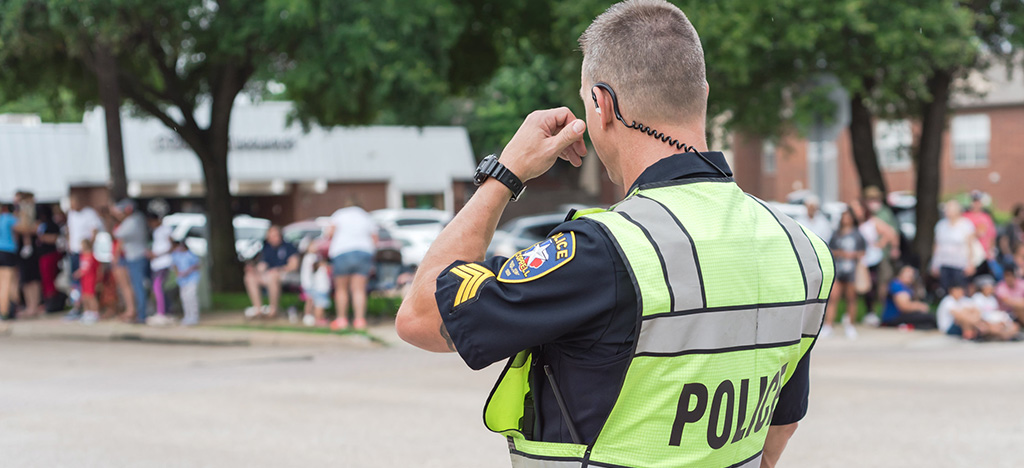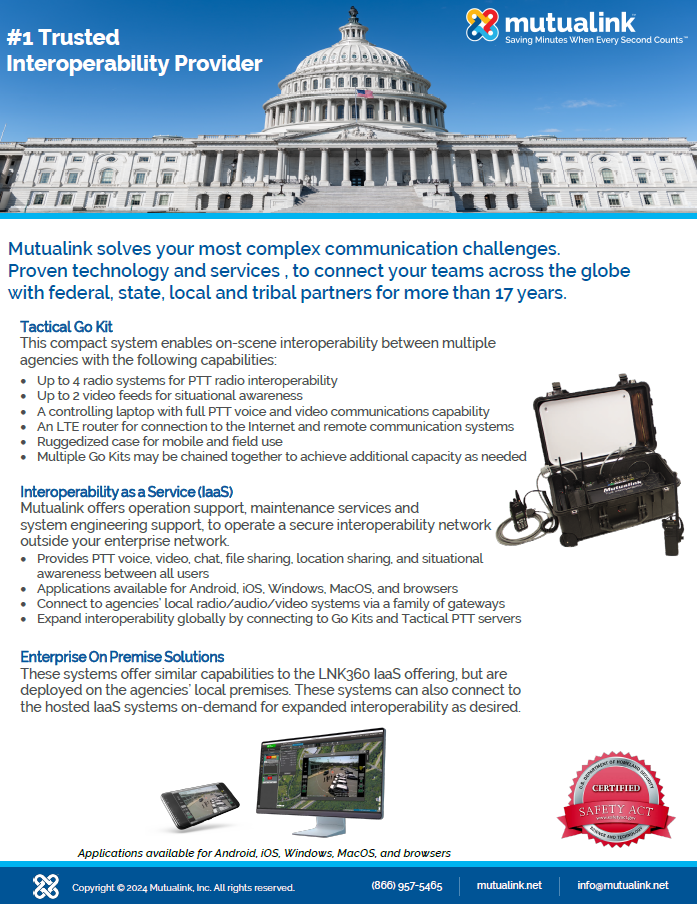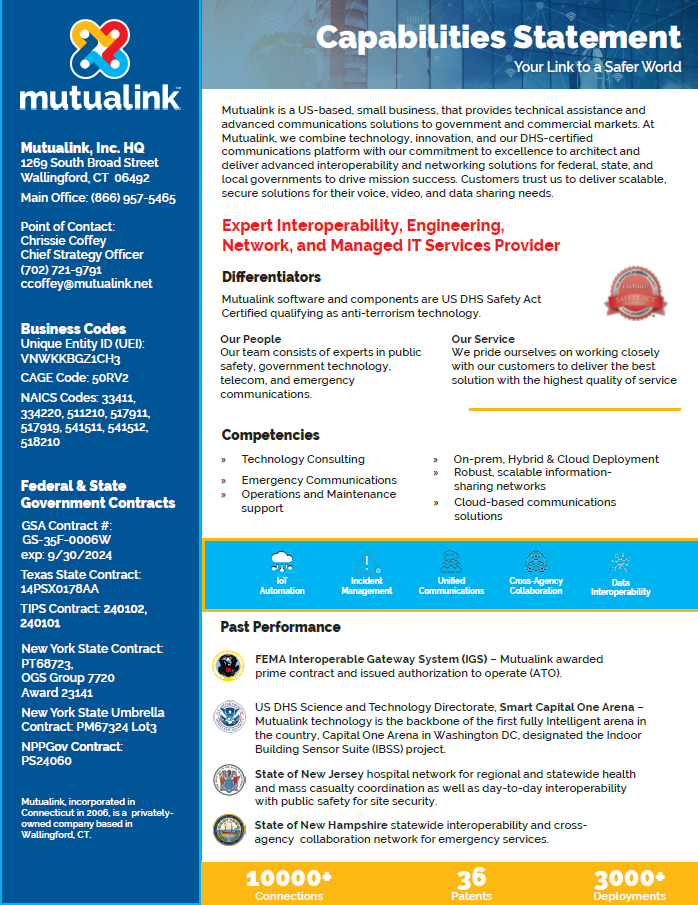Preserving Lives
Mutualink’s mission is to improve government services and public safety by enabling faster, well-informed emergency responses to public safety threats. Today, our technology provides instant, real-time, on-demand access to voice, video, data, and text, dramatically reducing initial response times.
Tactical Go-Kit
Mutualink solves your most complex communication challenges. Proven technology and services, connecting teams across the globe with federal, state, local and tribal partners for more than 17 years.
Download our Tactical Go-Kit Brochure to learn more.
Federal Government Support
Federal Government Contact
Chrissie Coffey | Chief Strategy Officer
Download our Federal Capabilities Statement to learn more.

Rapid Emergency Response
Mutualink empowers your emergency response by alerting multiple agencies to simultaneously receive alerts in less than 8 seconds through automation.
First responders can be dispatched automatically, improving both response times and time to resolution.

Improved Situational Awareness
Advanced situational awareness of on-scene status leads to more specific actions and accelerated time to resolution.
Emergency responders have instant access to all critical information, including video, floor plans, audio, and other IoT sensor data. Shared communications are established instantaneously across multiple agencies.

Incident Management
Previously unavailable information flows seamlessly in real-time to control centers. Advanced two-way intelligence can flow between Federal Government, State, Local, Tribal, Territorial (SLTT), and private sector partners.
Users in remote locations can connect to command and control centers, creating a lifeline for small groups or lone workers with low connectivity.

Platform Flexibility
Mutualink is the only platform that seamlessly enables two-way communication using existing emergency tools and technology.
Seamlessly connect analog, digital, PTT, LMR, P25, LTE, cell phones, video, sound, IoT sensors, and panic buttons, enhancing situational awareness with floor plans and other data.
Case Studies
U.S. Department of Homeland Security | Search & Rescue | Disaster Response/Restore
Wildland Fires | National Guard | Ports of Entry | Smart Arena
U.S. Department of Homeland Security – Safety Act Certified
Mutualink is the only multimedia communications product that is Safety Act Certified and included on the approved products list for Homeland Security.
Mutualink powers and manages the Interoperable Gateway System (IGS), part of the U.S Government’s National Continuity Program (NCP), whose mission is to provide last-line resilient communications during a national or large-scale catastrophe.
Search and Rescue – Police, Fire, Medical, and National Guard
A Search and Rescue (SAR) task force required secure, portable communications and access to drone feeds, fixed and rotary wing assets. Data was shared with subject matter experts with command and control authority.
The team of ground search and rescue (GSAR) experts with dogs, rigging specialists, physicians, hazardous material, and communications specialists were responsible for high mountain and desert environments. On orders, the team assembled from local police, fire, medical, and National Guard components.
Mutualink provided a communications kit that delivered an instant voice across all radio units and shared live video feeds from drone footage to dispatchers, command vehicles, and incident command. The legacy communications gear was a mix of VHF/AM and FM, UHF conventional, digital trunked, P25, satellite, and cellular phones.
Disaster Response/Restore – In Areas with no Communications Infrastructure
Mutualink has organized deployments to every major hurricane disaster site since Katrina hit New Orleans in 2005.
Since our founding in 2006, tragic events have driven our innovation. Mutualink can connect where no infrastructure exists, and we are not dependent on any one infrastructure. Our focus is on providing response team interoperations the ability to coordinate relief efforts for people impacted by tragedy—whether created by nature or man.
The hurricanes of 2017—Harvey, Irma, and Maria further proved that our interoperable communications could support community responses across all local, state, and federal responders. We brought portable cellular towers provided by wireless carriers for coverage, discrete radio kits from all over the country, satellite providers, Guard teams, and the entire first responder community together for concerted responses by multiple responders at all three weather events.
Wildland Fires – Scalable Communications
Personnel and logistic challenges of fighting forest fires need communications support. At Mutualink, we have delivered scalable communications across jurisdictions to individual firefighters to provide secure real-time information – both voice and data as needed. We combine legacy mutual aid radio channels with Satcom, cellular, and P25 radio networks. Our technology can combine old radios on any frequency.
National Guard – Joint Incident Communications Capability (JISCC)
Communications support for deployed National Guard (NG) and Air National Guard (ANG) units was provided by Joint Incident Communications Capability (JISCC) trailers and comms vehicles.
In 2018, a Disaster Incident Response Emergency Communications Terminal (DIRECT) was added as a comms tool. Mutualink kits now supplement access to FEMA’s communications backbone, telephones, existing cellular networks, and any state, local or tribal communications in operation for an incident across the country.
Ports of Entry – Border and TSA Communications
Airports and harbors are multi-jurisdictional points of exit and entry. Mutualink bridges communications between border and transportation security administrators, airport authorities, and terminal and airline staff. We can share internal and external camera feeds, traffic cameras, and even vessel IDs with operators protecting the terminals.
Smart Arena – Capital One, Washington, D.C.
Under a competitive award from DHS Science and Technology Directorate, Mutualink technology has created the first fully Intelligent arena in the country, Capitol One Arena in Washington DC, designated the Indoor Building Sensor Suite (IBSS) project. The project aims to establish a testbed facility for testing and evaluation of indoor building sensors and associated building analytics developed to improve overall building safety and performance.


